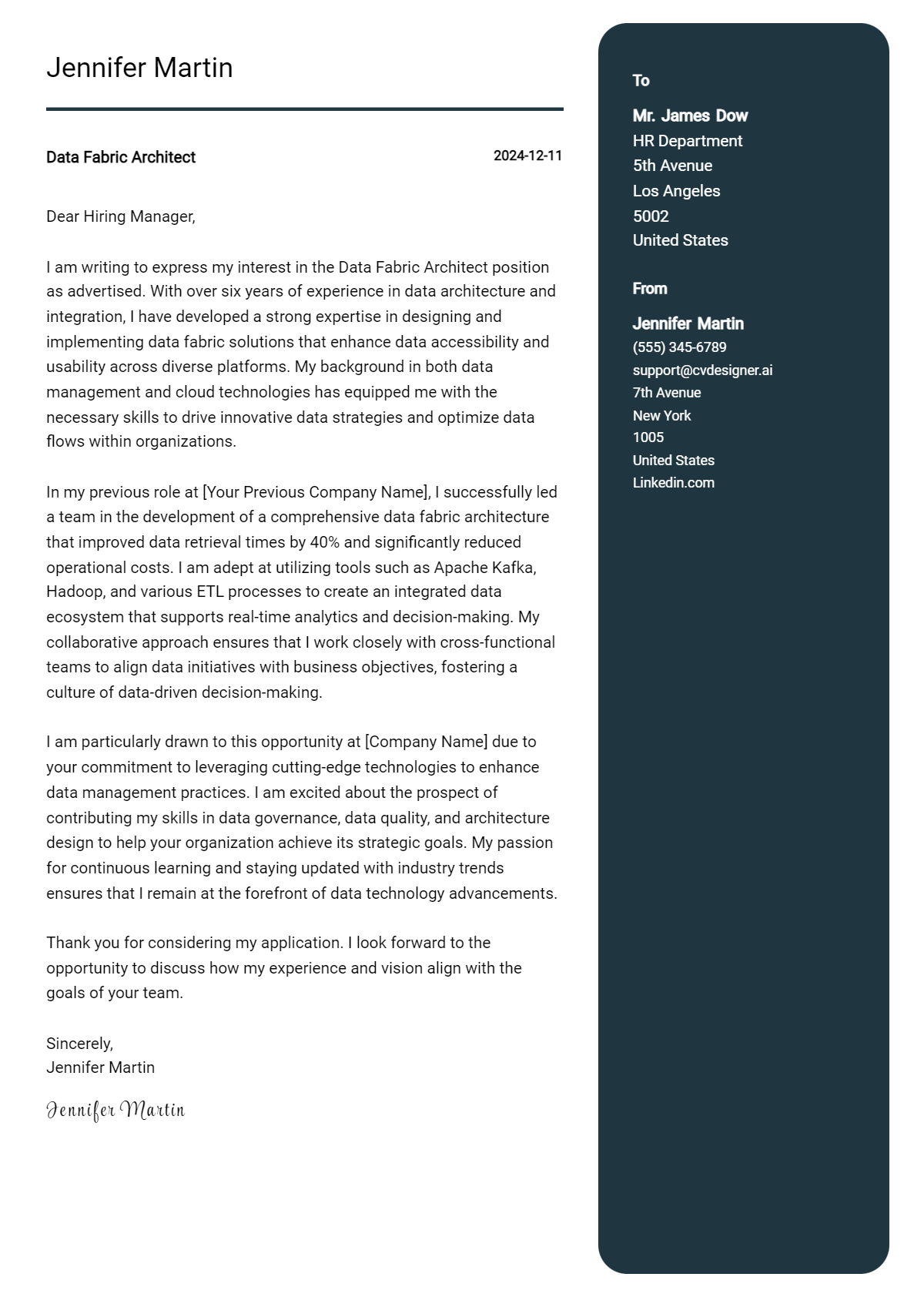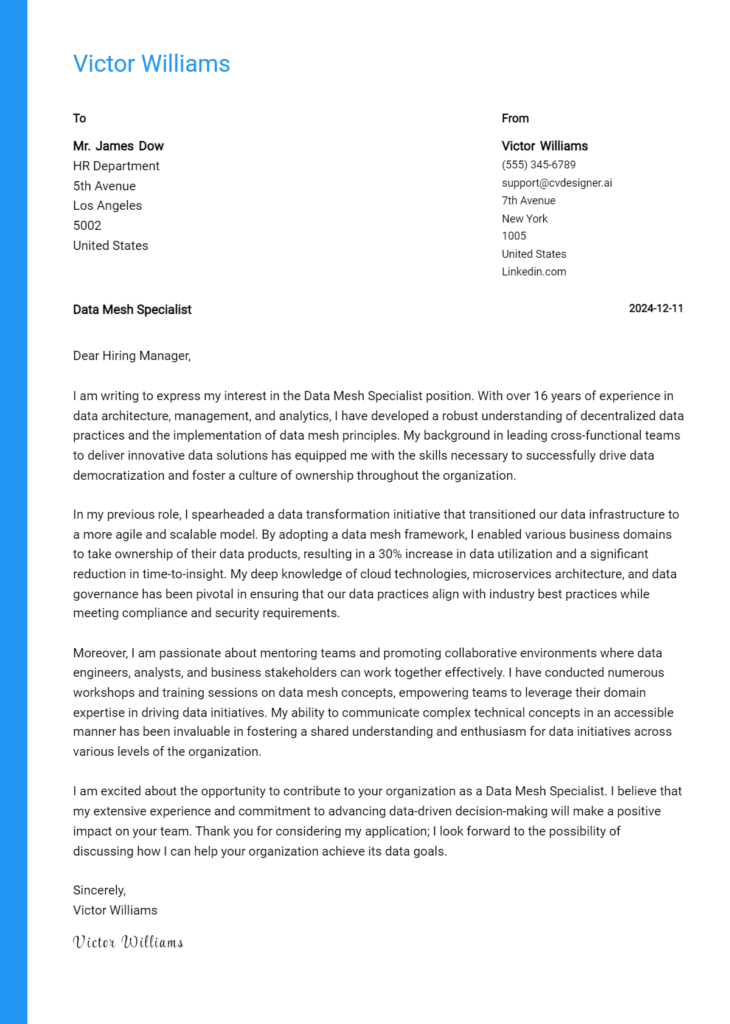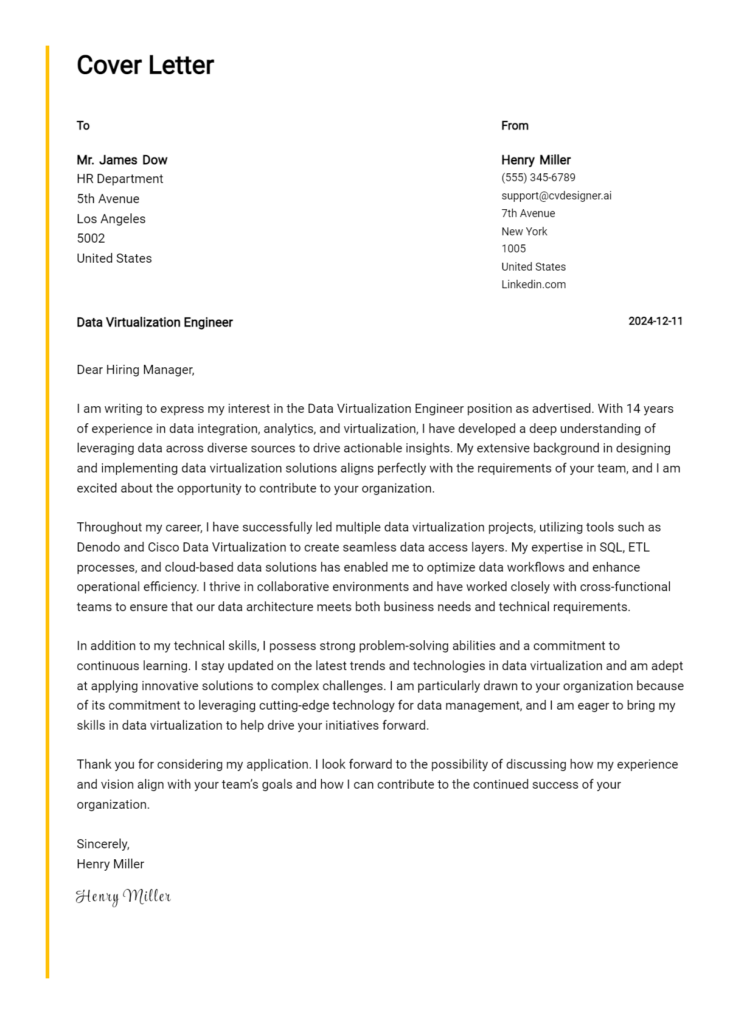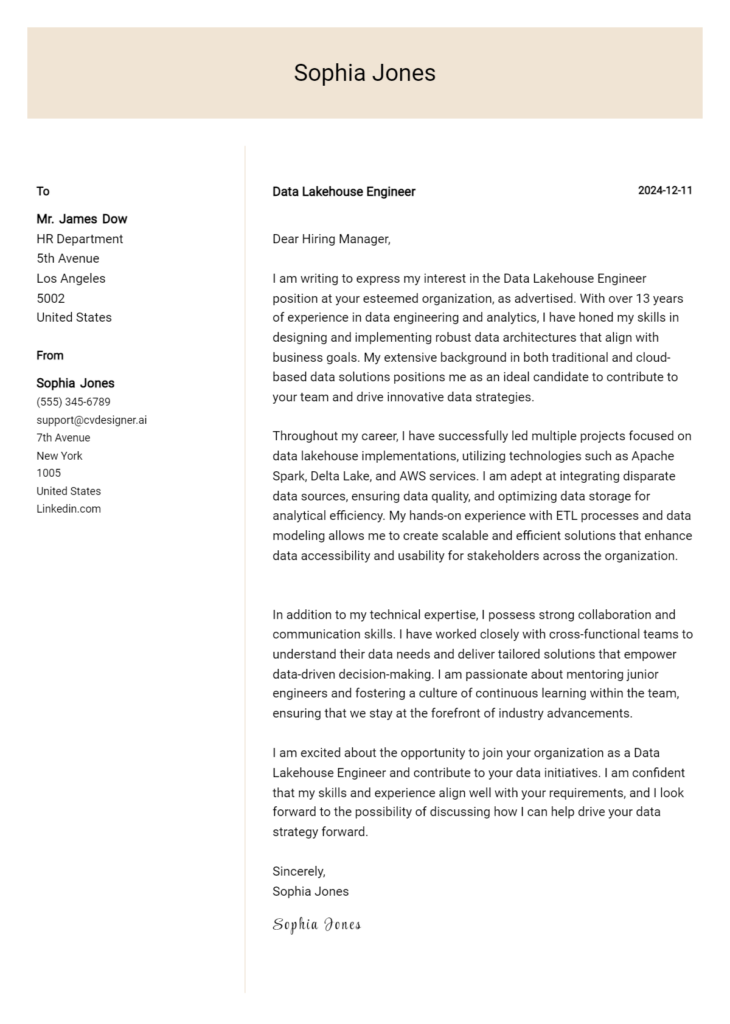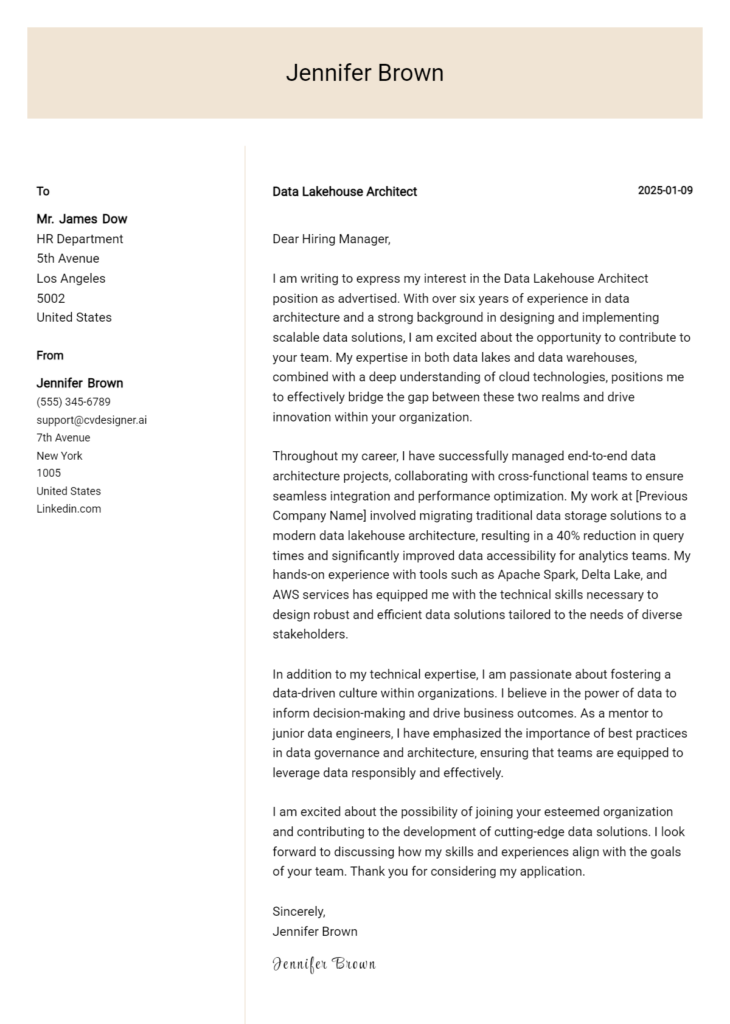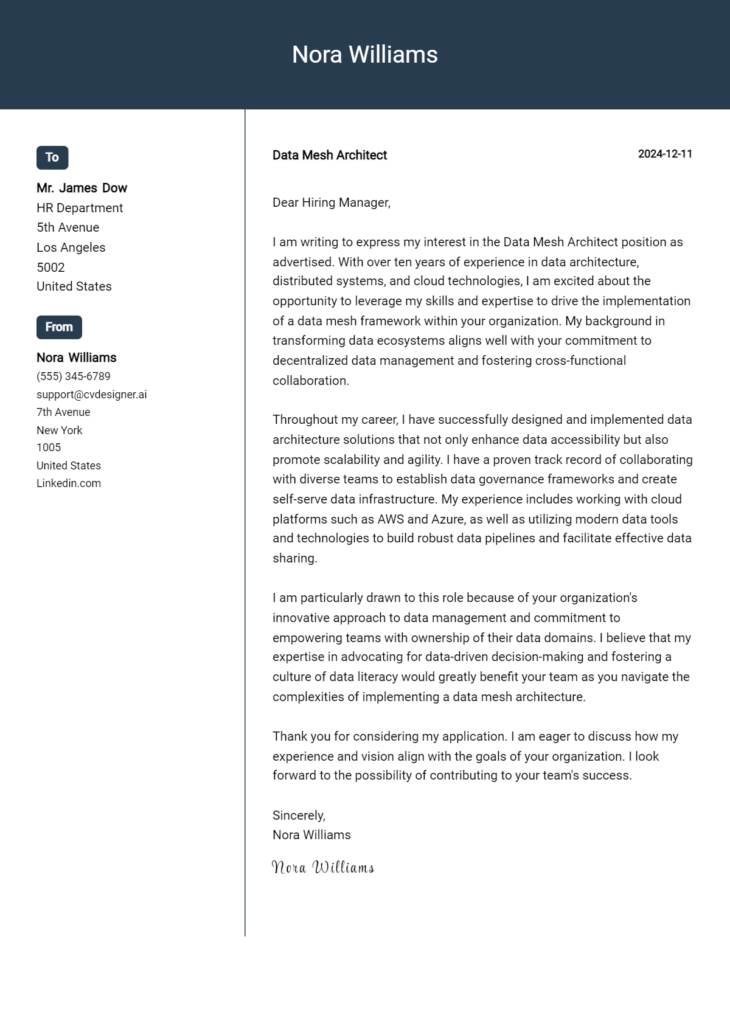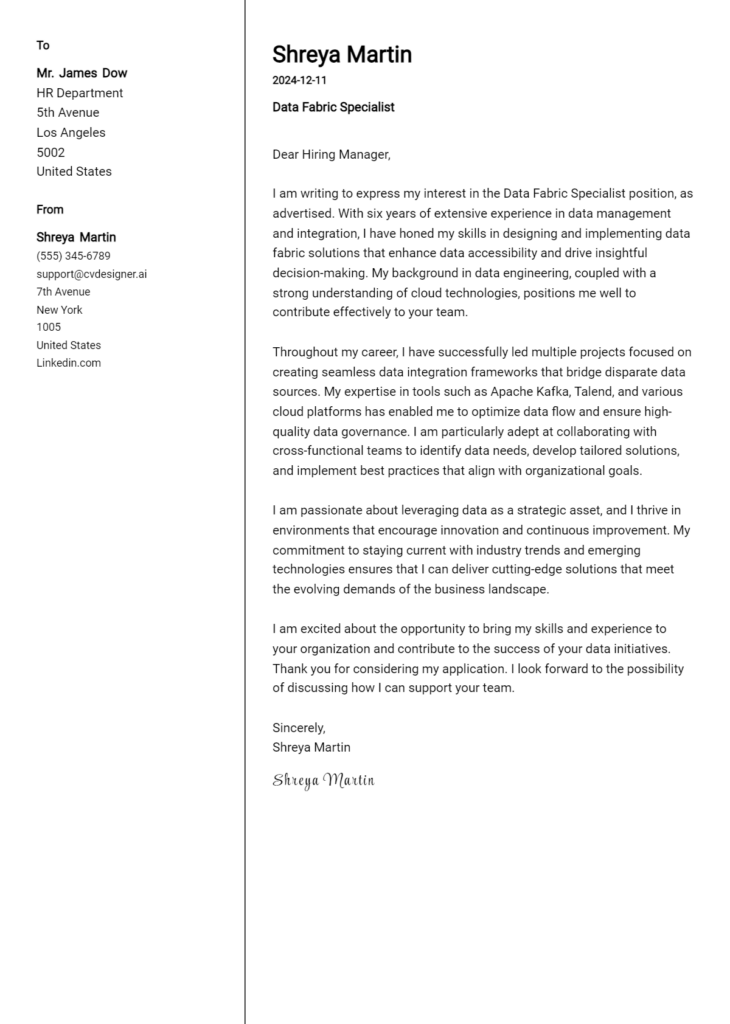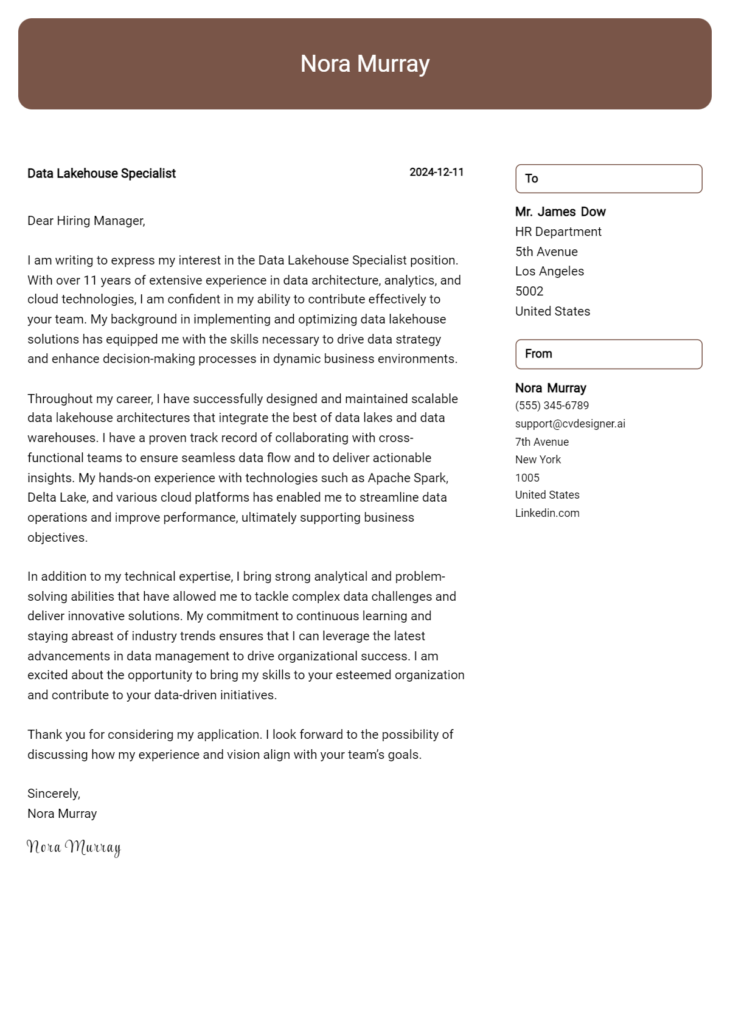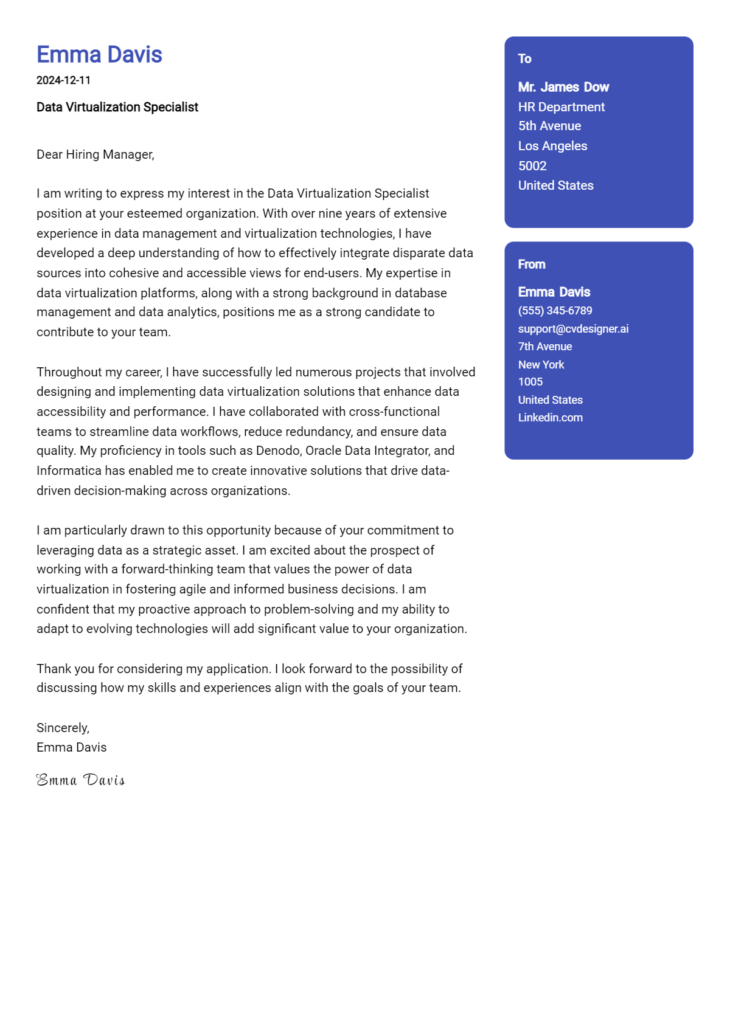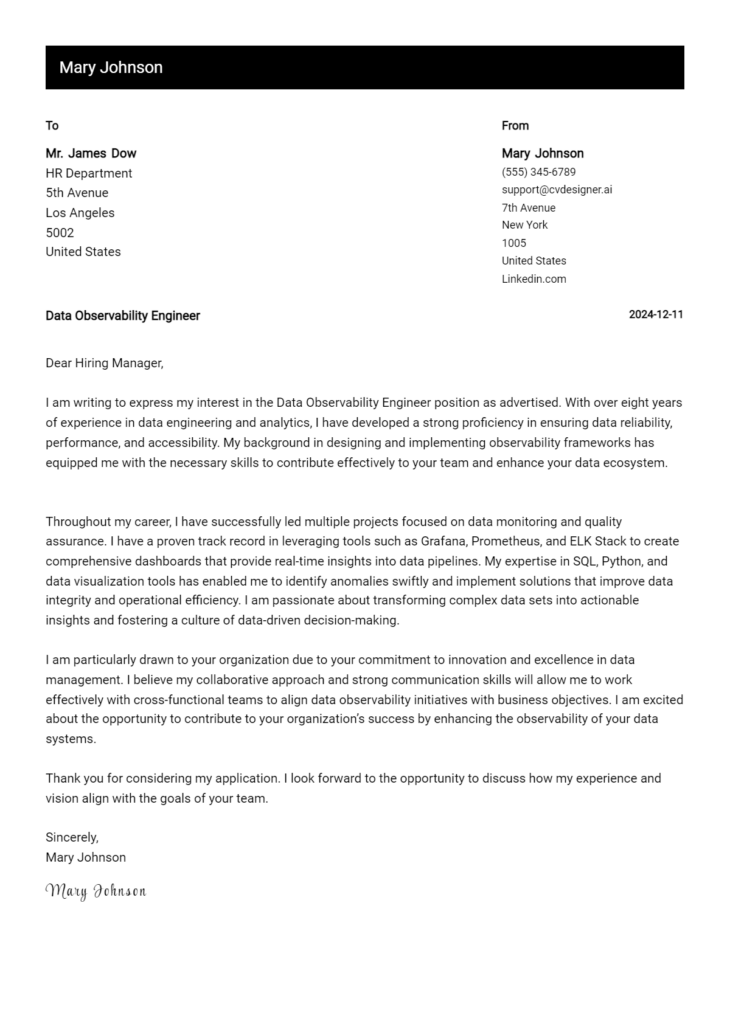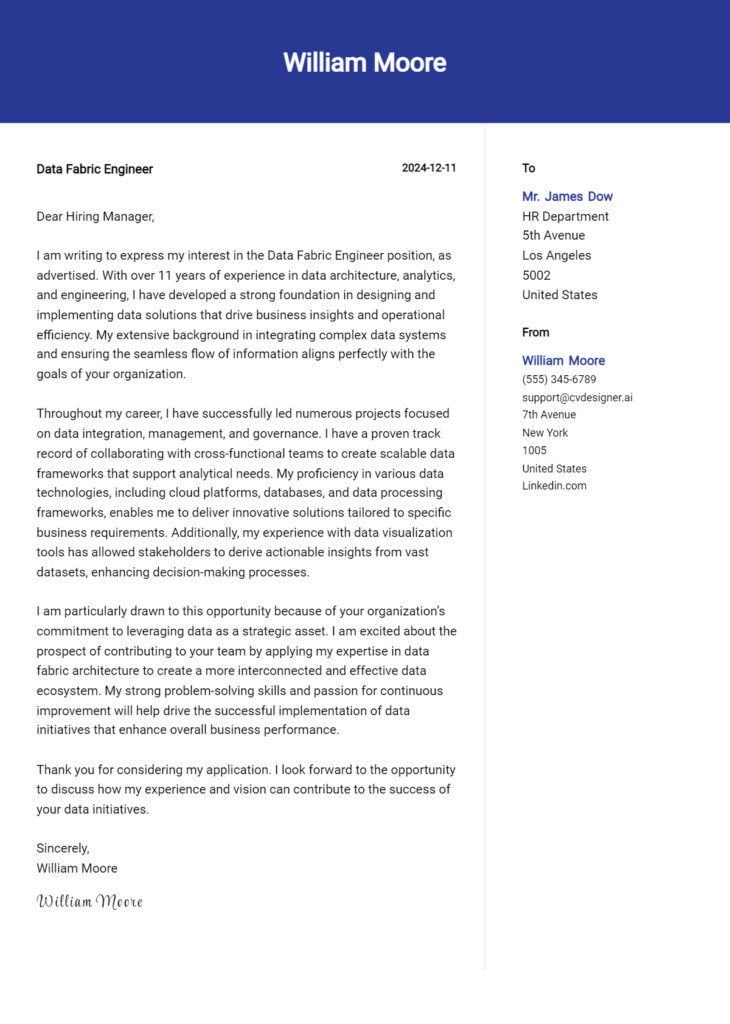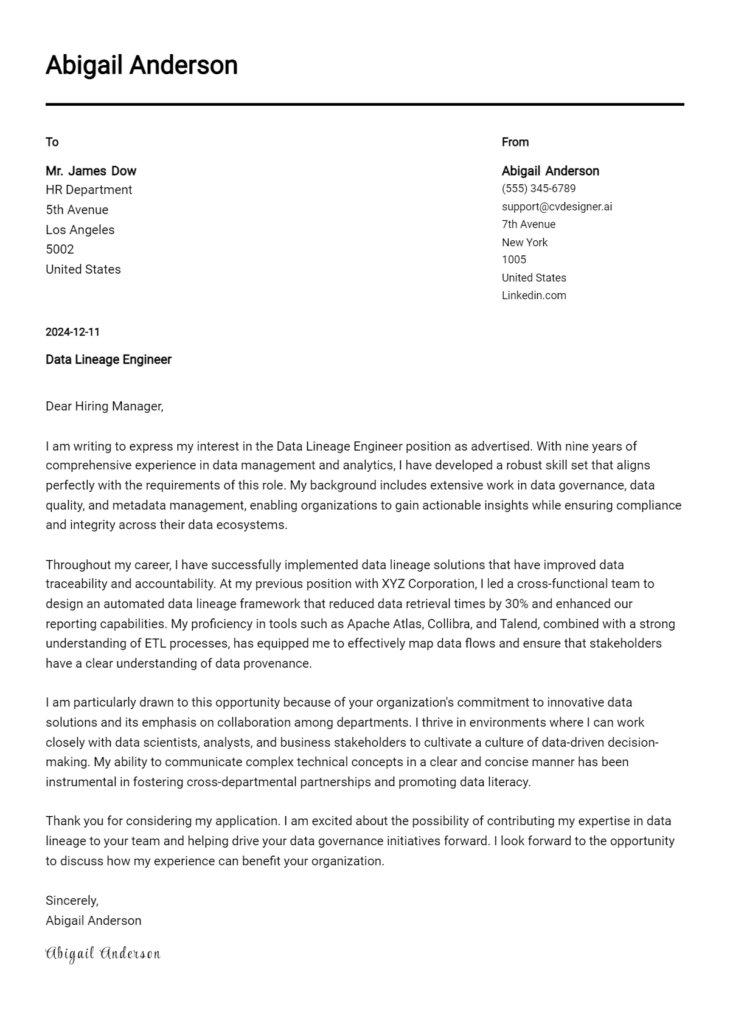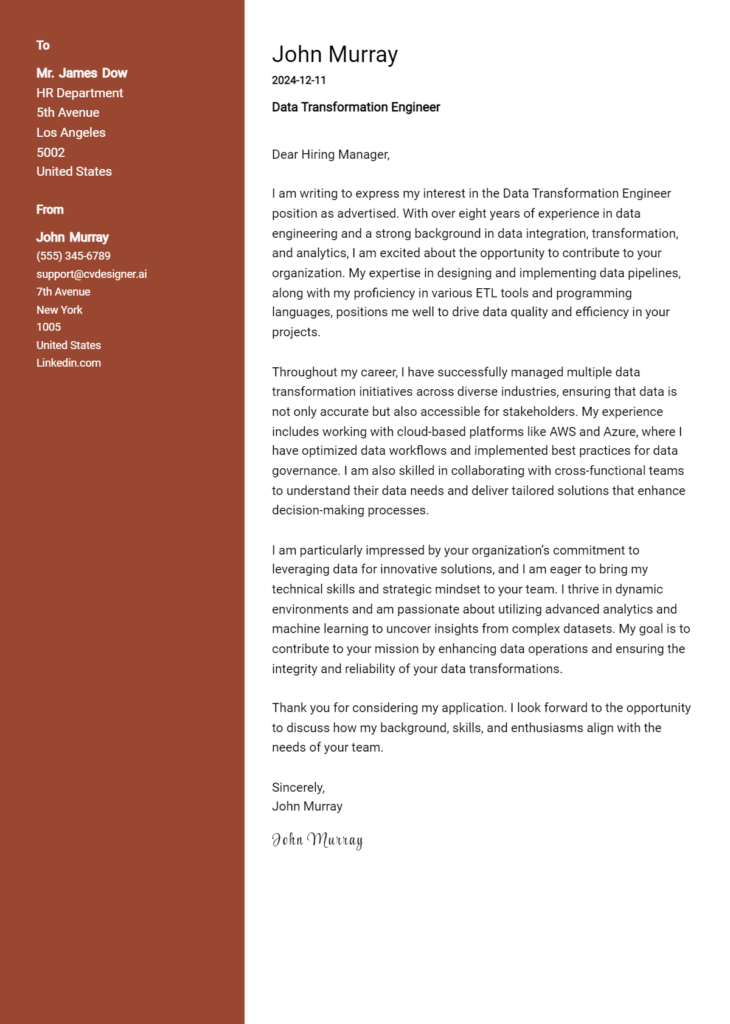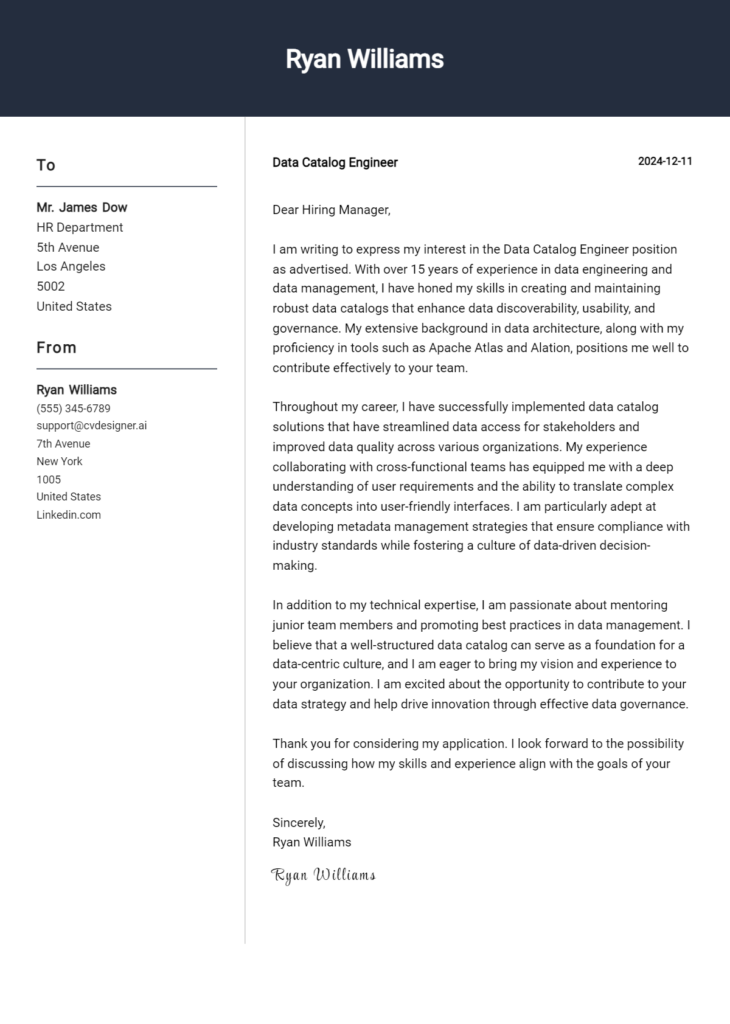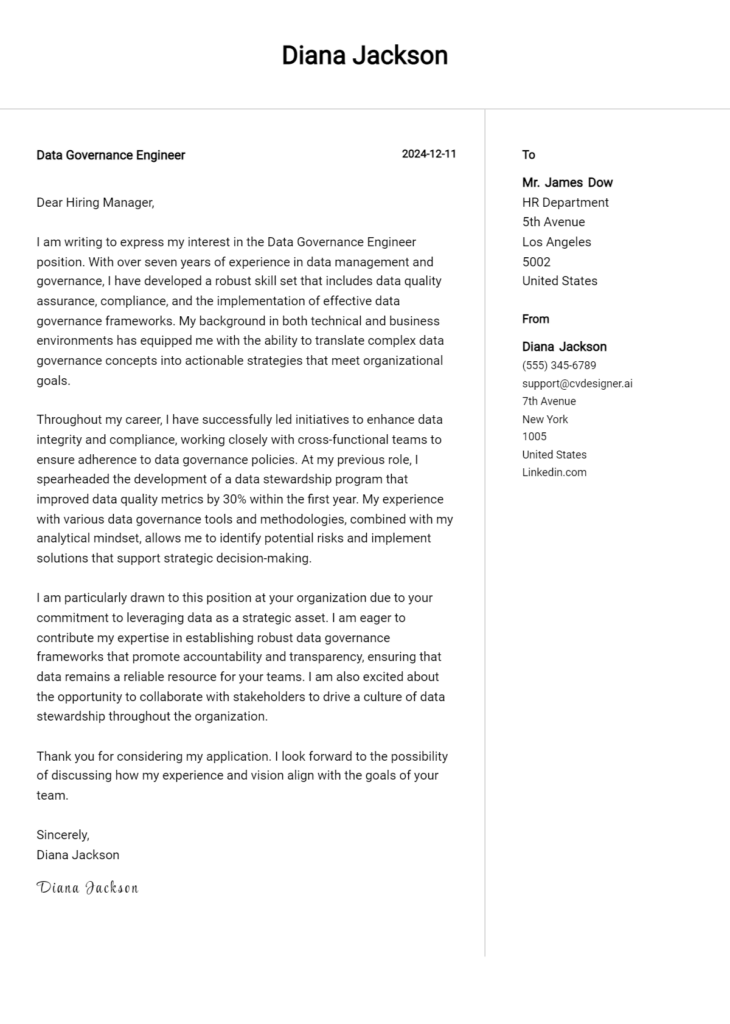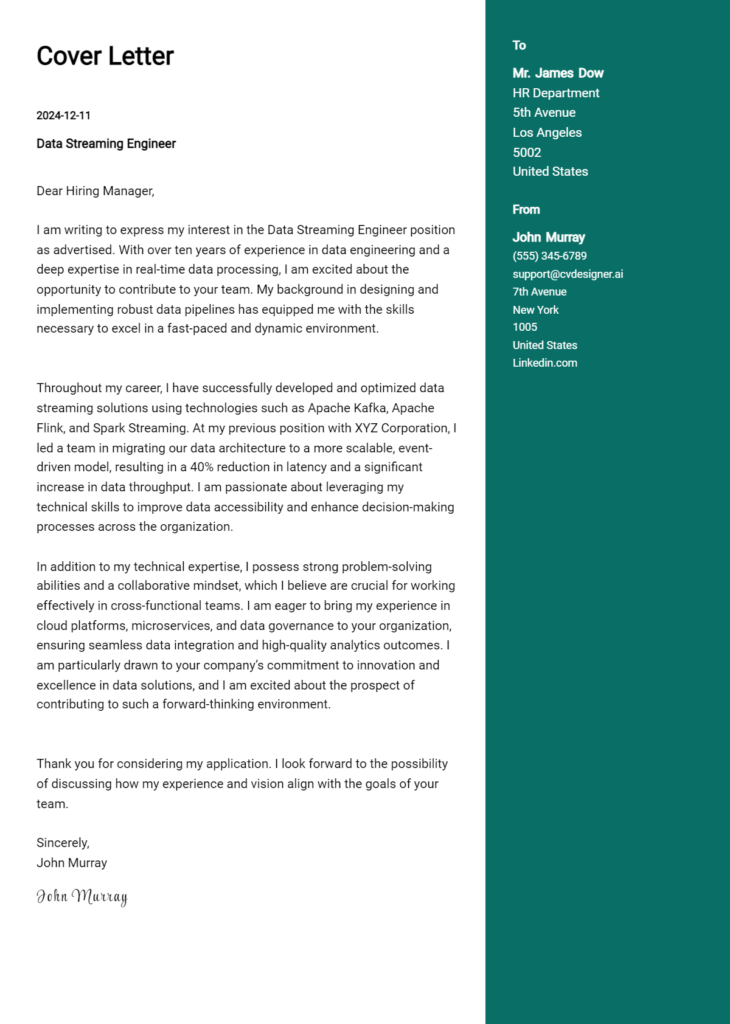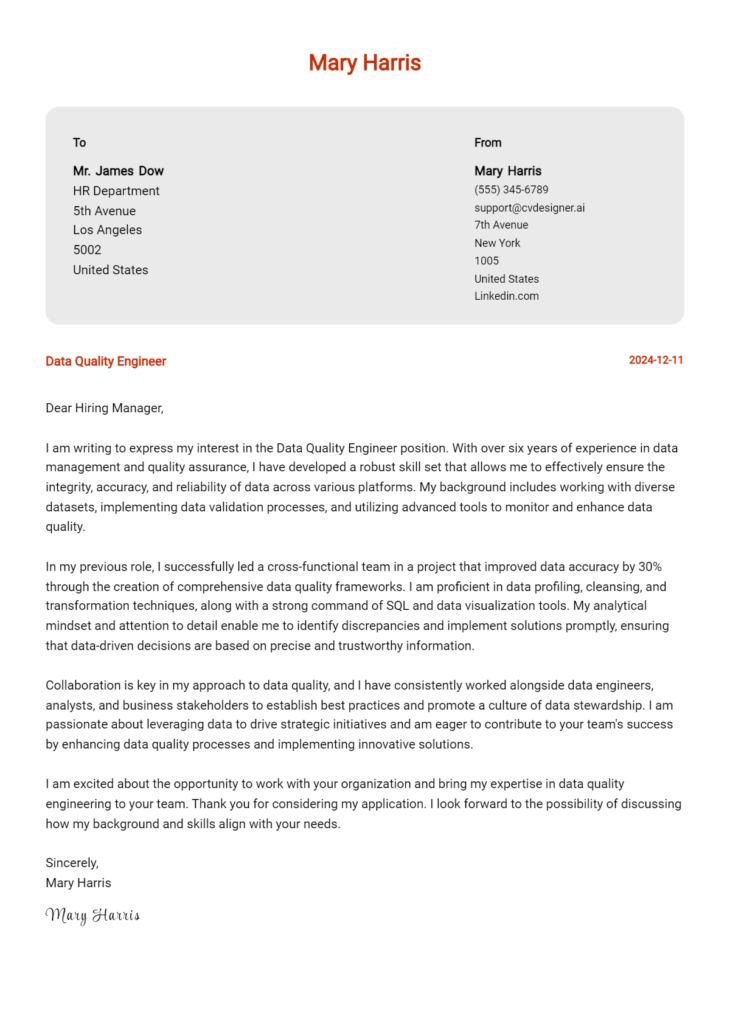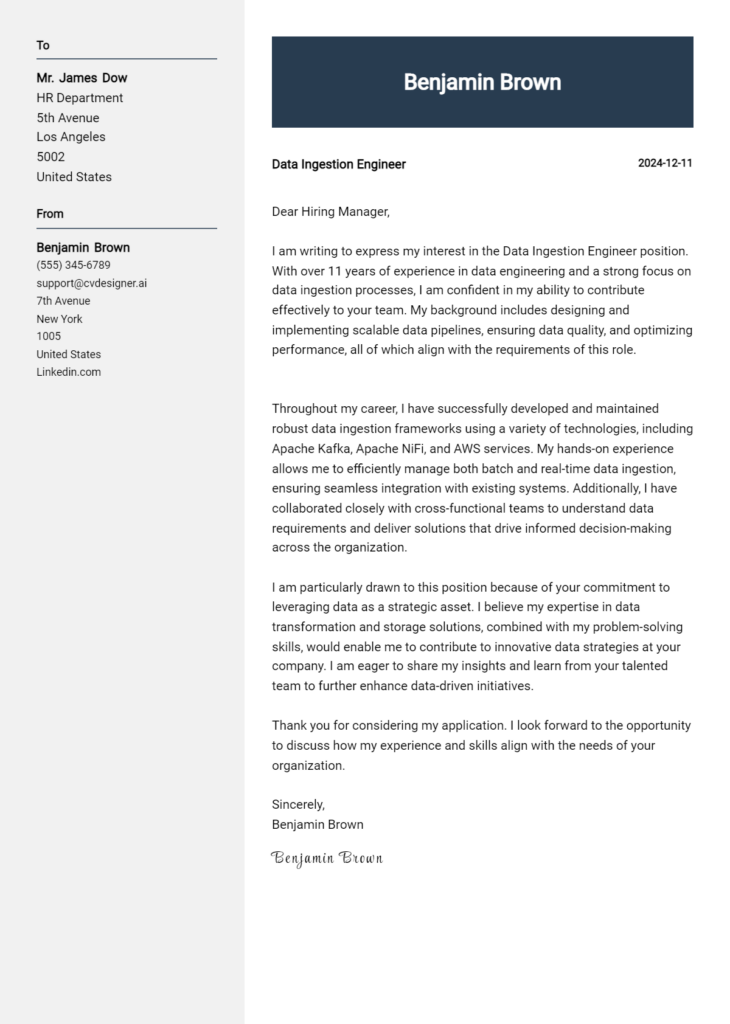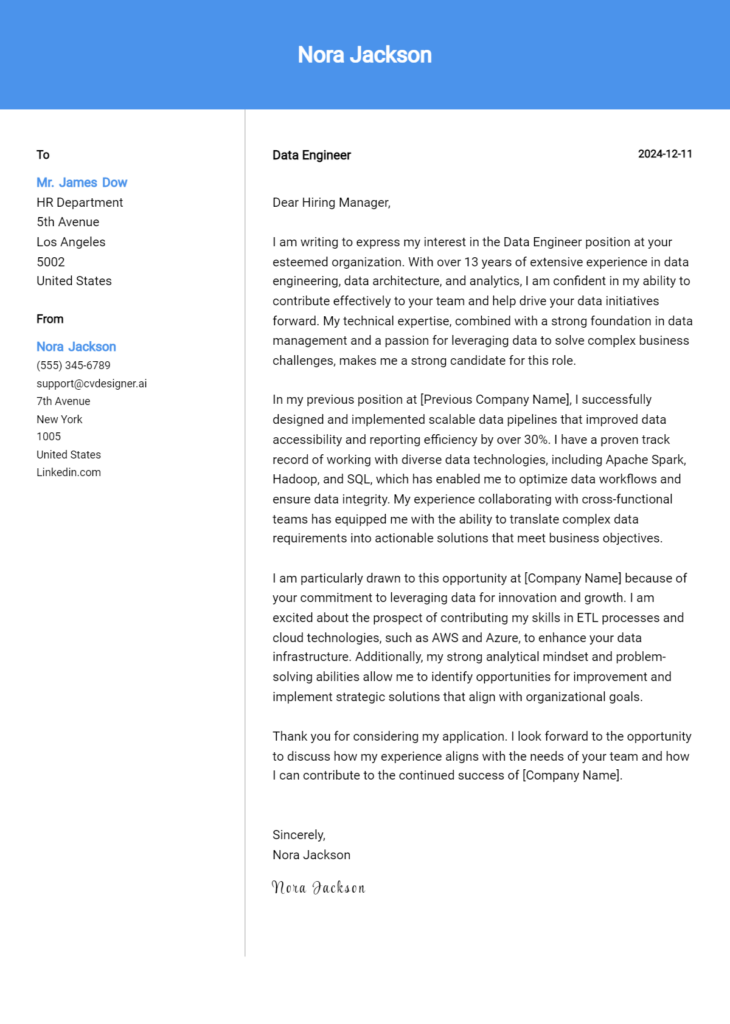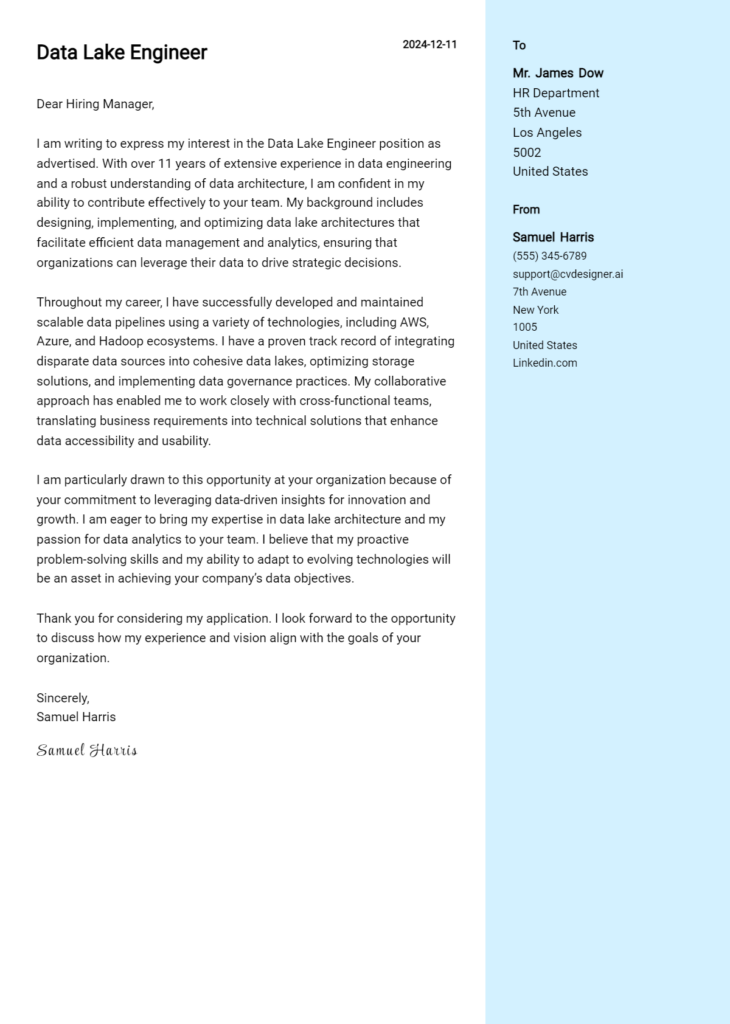Data Fabric Architect Cover Letter Examples
Explore additional Data Fabric Architect cover letter samples and guides and see what works for your level of experience or role.
How to Format a Data Fabric Architect Cover Letter?
Crafting a compelling cover letter is essential for a Data Fabric Architect, as it serves as your first opportunity to make a lasting impression on potential employers. The way you format your cover letter not only showcases your qualifications but also reflects your understanding of data architecture principles, emphasizing your analytical skills and attention to detail. A well-structured cover letter can effectively communicate your technical expertise and innovative mindset, which are crucial in this rapidly evolving field.
In this guide, we will outline the key components of a professional cover letter, including:
- Cover Letter Header
- Cover Letter Greeting
- Cover Letter Introduction
- Cover Letter Body
- Cover Letter Closing
Each section is vital in presenting your capabilities and professionalism. Let’s delve into each part and explore how to make your Data Fabric Architect cover letter stand out.
Importance of the Cover Letter Header for a Data Fabric Architect
The cover letter header is a crucial element that sets the tone for your application as a Data Fabric Architect. It should provide essential information such as your contact details, the date, and the recipient's information, all presented in a clear and professional format. A well-structured header not only enhances the readability of your cover letter but also conveys your attention to detail and professionalism—qualities that are vital in the field of data architecture. A strong header can make a positive first impression, while a poorly formatted one can detract from the overall effectiveness of your application.
Here are examples of a strong and weak cover letter header for a Data Fabric Architect:
Strong Example
John Doe 123 Main Street City, State, Zip john.doe@email.com (123) 456-7890 October 5, 2023 Jane Smith Hiring Manager ABC Corporation 456 Industry Blvd City, State, Zip
Weak Example
hey there myaddress 1234 justemail@domain.com 10/5/23 Hiring Person Company Name
The Importance of the Cover Letter Greeting
The greeting of your cover letter serves as the first impression you make on a potential employer, setting the tone for the rest of your application. A well-crafted greeting demonstrates professionalism and shows that you have taken the time to personalize your letter by addressing the hiring manager directly. This approach not only helps to establish a connection but also reflects your genuine interest in the position. To avoid generic greetings like "To Whom It May Concern," it is crucial to conduct a bit of research to find out the name of the hiring manager or recruiter. This small effort can significantly enhance the impact of your cover letter.
Strong Greeting Example
Dear [Hiring Manager's Name],
Weak Greeting Example
To Whom It May Concern,
The Importance of a Cover Letter Introduction for a Data Fabric Architect
A well-crafted cover letter introduction is crucial for capturing the attention of hiring managers, especially for specialized roles like a Data Fabric Architect. This initial paragraph sets the tone for the entire letter, allowing candidates to express their enthusiasm for the position while highlighting relevant skills and achievements. An effective introduction not only piques interest but also establishes a connection between the candidate's background and the job requirements. Below are examples of strong and weak introductions to illustrate the difference.
Strong Example
Dear [Hiring Manager's Name], As a seasoned Data Fabric Architect with over eight years of experience in designing and implementing scalable data architectures, I am excited to apply for the Data Fabric Architect position at [Company Name]. My passion for transforming complex data ecosystems into streamlined, efficient systems aligns perfectly with your organization's commitment to innovative data solutions. Notably, in my previous role at [Previous Company], I led a cross-functional team that successfully reduced data retrieval times by 40%, enhancing operational efficiency and driving strategic decision-making.
Weak Example
Hello, I am writing to apply for the Data Fabric Architect job. I have some experience in data management and think I could do well in this role. I have worked with data before, and I hope to contribute to your team.
Importance of the Cover Letter Closing for a Data Fabric Architect
The closing paragraph of a cover letter is crucial as it serves to summarize the applicant's qualifications, reiterate their enthusiasm for the Data Fabric Architect role, and encourage the hiring manager to take the next steps, such as reviewing the resume or scheduling an interview. A strong closing leaves a lasting impression, reinforcing the candidate's fit for the position and eagerness to contribute to the organization's success, while a weak closing may fail to convey confidence or clarity, potentially diminishing the candidate's appeal.
Strong Example
In closing, I am excited about the opportunity to leverage my extensive experience in data architecture and my expertise in data fabric solutions to drive innovation at [Company Name]. I am confident that my skills in data integration, governance, and analytics will greatly benefit your team. I look forward to the possibility of discussing my application further and hope to schedule an interview at your earliest convenience. Thank you for considering my application.
Weak Example
Well, I guess that's it. I hope you look at my resume, and maybe we can talk later. Thanks, I suppose.
Common Mistakes to Avoid in a Data Fabric Architect Cover Letter
Crafting an effective cover letter is essential for making a strong impression as a Data Fabric Architect. Avoiding common pitfalls can significantly enhance your chances of landing an interview. Here are several mistakes to steer clear of:
Generic Content: Tailoring your cover letter to the specific role is crucial. Avoid using a one-size-fits-all approach. Research the company and mention how your skills align with their needs.
Neglecting the Format: A poorly formatted cover letter can distract from your message. Ensure your letter follows a professional cover letter format that enhances readability.
Lack of Specific Examples: Failing to provide concrete examples of your experience can weaken your application. Highlight your achievements and how they relate to data fabric architecture.
Overly Technical Language: While technical knowledge is vital, using jargon excessively can alienate non-technical readers. Aim for clarity and balance your technical expertise with accessible language.
Ignoring the Call to Action: Ending your letter without a strong call to action can leave a weak impression. Politely express your desire for an interview and indicate your availability.
Typos and Grammatical Errors: Simple mistakes can undermine your professionalism. Proofread your cover letter or use tools to check for errors before submitting.
Missing Personal Connection: Failing to convey your enthusiasm for the role or the company can make your letter forgettable. Share why you are passionate about data architecture and how you can contribute to the organization.
For inspiration, consider reviewing some cover letter examples to see how successful candidates have effectively expressed their qualifications and enthusiasm.
Cover Letter FAQs for Data Fabric Architect
What should I include in my cover letter for a Data Fabric Architect position?
In your cover letter, emphasize your experience with data architecture, integration, and management. Highlight specific projects where you've implemented data fabric solutions, showcasing your understanding of data governance, quality, and security. Describe your proficiency in cloud platforms and tools relevant to data fabric, such as data lakes, ETL processes, and real-time analytics. Additionally, mention your collaboration with cross-functional teams and your ability to translate business requirements into technical solutions. Tailor your letter to the job description, using keywords that reflect the skills and experiences the employer is seeking.
How can I demonstrate my technical skills in the cover letter?
To effectively demonstrate your technical skills, use specific examples from your previous work experiences. For instance, discuss a project where you successfully integrated disparate data sources using a data fabric approach. Mention the technologies and tools you utilized, such as Apache Kafka, Hadoop, or cloud services like AWS and Azure. Incorporate metrics to quantify your impact, such as reduced data retrieval time or improved data accuracy. Additionally, reference any relevant certifications or training that validate your expertise, ensuring that hiring managers see you as a qualified candidate for the role.
Should I address my cover letter to a specific person?
Yes, addressing your cover letter to a specific person can significantly enhance its impact. It shows that you've done your research and are genuinely interested in the position. If the job listing doesn't specify a name, consider checking the company’s website or LinkedIn to find the hiring manager's name. If you can't find a specific person, use a general greeting like "Dear Hiring Manager." Personalizing your cover letter can help you stand out and demonstrate your enthusiasm for the role, making a positive impression on the reader.
How long should my cover letter be?
Your cover letter should ideally be one page long, typically around 300-400 words. This length allows you to provide enough detail about your experience and skills without overwhelming the reader. Keep your language concise and focused, ensuring that every sentence adds value. Use short paragraphs and bullet points where appropriate to enhance readability. Remember to structure your letter with an introduction, body, and conclusion, making it easy for hiring managers to follow your narrative and understand your qualifications for the Data Fabric Architect position.
Build your Cover Letter in minutes
Use an AI-powered cover letter builder and have your letter done in 5 minutes. Just select your template and our software will guide you through the process.

